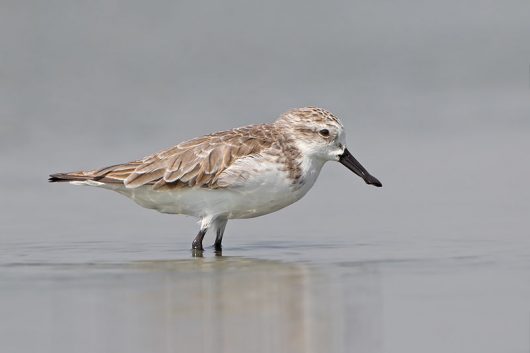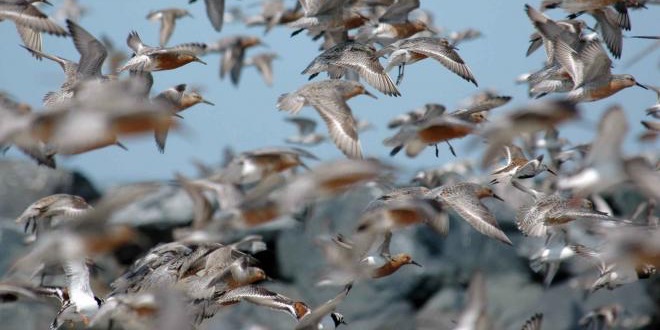High adult annual survival rate is critical to population stability, but how do shorebird survival rates vary around the world?
LINKED PAPER
Patterns and processes shorebird survival rates: a global review. Verónica Méndez, Jose A. Alves, Jennifer. A Gill & Tomas G. Gunnarsson. 2018. IBIS. DOI: 10.1111/ibi.12586. VIEW
Changes in demographic rates underpin changes in population size. For long-lived shorebirds (waders), the maintenance of a high adult annual survival rate is critical to population stability, as recent studies of shorebirds that are dependent on stop-over areas in the Yellow Sea illustrate (Studds et al., 2017). Here, a sudden change in annual adult survival, as established through colour-ring sightings, highlighted the role of the removal of large areas of mudflats (Piersma et al., 2016), and led to urgent and welcome conservation action in China, South Korea and North Korea. Survival measures can therefore be hugely important for identifying conservation needs, but how do shorebird survival rates vary around the world?

When trying to compare biological processes across the globe, it is important to be able to compare like with like. Measures of annual survival rates can be particularly challenging to obtain because large-scale, long-term tracking of individuals is difficult and the resulting data may contain many inherent biases. In this review paper in IBIS, we amassed 295 estimates of annual survival from for 56 shorebird species and investigated how the data and analytical methods used can affect the estimates obtained. Then, we explored the variation in survival rates in relation to biological and ecological factors, accounting for the analytical method used.
Shorebird survival rates can be estimated from recoveries of dead marked individuals and/or recaptures or resightings of marked individuals through their lives, and calculated either as simple rates of return to a breeding or winter location, or as survival probabilities using recovery, mark-recapture or more complex models. Our review shows that estimates calculated from return rates are significantly lower than estimates from mark-recapture models. This underestimation of survival from return rates is likely to occur because individuals that may have moved to a different location (but still be alive) are assumed to be dead. Estimates from return rates should therefore always be considered as minimum survival rates. However, encouragingly, studies that used recoveries of dead individuals alone or in combination with resighting data provided estimates that did not differ from those that used only repeated sightings of live individuals. This suggests that shorebirds that are found dead are not likely to be a biased subset of the wider population (e.g. by having emigrated to sites with low resighting coverage), and reflects the fact that most shorebirds are highly site-faithful, returning to the same breeding and non-breeding sites throughout their life.
Great Knot, Kimberley, Western Australia | Julie Burgher/sunphlo CC-BY-SA-2.0 Wikimedia Commons
Having accounted for the variation in survival estimates that is caused by the analytical method used, we were then able to quantify how survival rates vary with body size (larger species tend to have higher survival rates than smaller species), across genera and flyways. These analyses suggest that published survival estimates from smaller shorebirds (Actitis, Calidris and Charadrius spp) and from the Americas tend to be lower than predicted by our model, most likely due to greater variability in detectability and/or lower levels of site fidelity in small shorebirds and the species studied within this flyway (most of which are also small shorebirds).
This comparison of studies of 52 species from 15 genera can be used to identify cases in which published values might over- or under-estimate survival rates (and by how much), to indicate the likely range of survival rates for species that have not yet been studied and/or to allow correction of estimates obtained from return rates (which may be the only option for researchers in some cases). The study also highlights species for which reliable estimates are hard to obtain, as with Actitis (Spotted and Common Sandpiper) species that are sometimes not as site-faithful as is the case for most shorebirds. We therefore hope that this will be a useful tool for shorebird biologists and conservationists and will stimulate research into the factors influencing detectability of shorebirds.
Although the number of published survival estimates for shorebirds has increased in recent years, estimates for species in areas currently experiencing environmental degradation are still relatively rare. For example, our capacity to assess flyway-level differences in survival rates was constrained by the limited number of estimates available from the Central Asian and East Asian-Australasian flyways, which support important and declining populations of many species (Studds et al. 2017). Similarly, too few estimates were available to explore changes in survival rates over time, but continued monitoring and reporting of survival will hopefully make such analyses more common in the future.

Accurate estimates of survival rates can potentially aid the rapid identification of locations in which species may be experiencing lower than expected survival. Given the global distribution of shorebirds, their sensitivity to environmental change, and the capacity of declines in adult survival rates to drive rapid declines in population size in these long-lived species, empirical quantification of survival across species’ ranges can be a valuable tool for identifying drivers of population change across regions and stages of the annual cycle. This review is restricted to shorebirds but one can imagine similar processes being applicable to the study of other groups of species, such as seabirds or waterfowl, that are distributed across the globe, and for which survival estimates may vary depending on the methods used to mark and track individuals and to analyse the resulting data.
We would like to end this blog by thanking all the authors that have monitored, measured and published shorebird survival rates across the globe. Understanding these global patterns requires an incredible amount of effort and data. A huge thank you to all of you!
References
Piersma T., Lok T., Chen Y., Hassell C.J., Yang H.Y., Boyle A., Slaymaker M., Chan Y.C., Melville D.S., Zhang Z.W., & Ma Z. 2016. Simultaneous declines in summer survival of three shorebird species signals a flyway at risk. Journal of Applied Ecology 53: 479–490. VIEW
Studds C.E., Kendall B.E., Murray N.J., Wilson H.B., Rogers D.I., Clemens R.S., Gosbell K., Hassell C.J., Jessop R., Melville D.S., Milton D.A., Minton C.D.T., Possingham H.P., Riegen A.C., Straw P., Woehler E.J., & Fuller R.A. 2017. Rapid population decline in migratory shorebirds relying on Yellow Sea tidal mudflats as stopover sites. Nature Communications 8: 14895. VIEW
Image credit
Featured image: Red Knot with leg flag | US Fish & Wildlife Service | PD US FWS
Blog posts express the views of the individual author(s) and not those of the BOU.
If you want to write about your research in #theBOUblog, then please see here.





